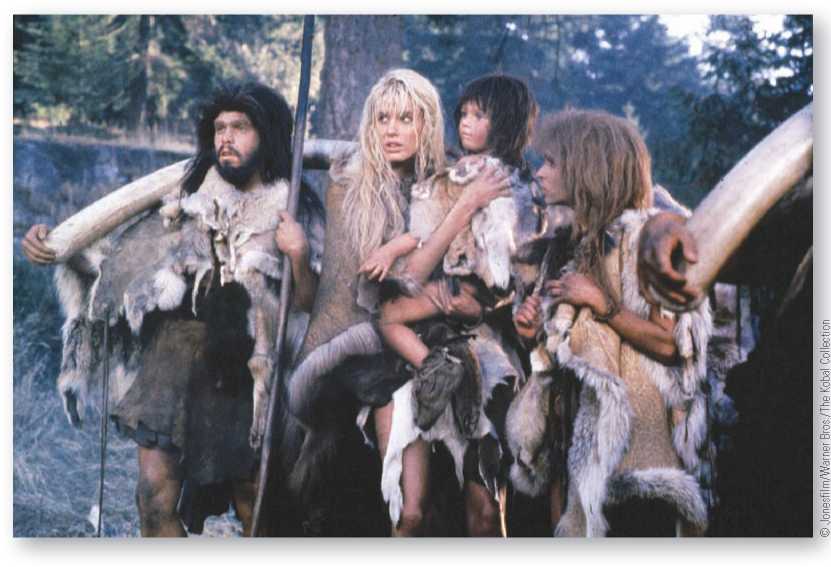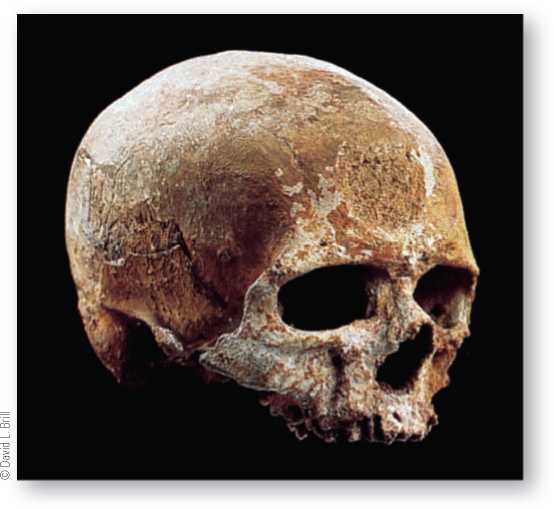What do we mean by modernity? Paleoanthropologists look at both skull shape of and cultural practices. But still this is a difficult designation to make. While Cro-Magnons resemble later populations of modern Europeans—in braincase shape, high broad forehead, narrow nasal openings, and common presence of chins—their faces were on average shorter and broader than those of modern

In the novel and movie Clan of the Cave Bear, the anatomically modern heroine is depicted as a tall blonde beauty while Neandertals are depicted as dark and sloppy. These images conform both to the stereotypes about Ne-andertals and aesthetic standards in the Western dominant culture.

With a high forehead, the Cro-Magnon skull is more like contemporary Europeans compared to the prominent brow ridge and sloping forehead seen in the Neandertal skull. Whether these differences in skull shape account for their cultural differences rather than their relative age is hotly debated. The more recent Cro-Magnon skull even preserves evidence of cultural continuity in diet with local contemporary French people. This skull has evidence of a fungal infection, perhaps from eating tainted mushrooms. Mushrooms are a delicacy in this region of France to this day.
Europeans, their brow ridges were a bit more prominent, and their teeth and jaws were as large as those of Neander-tals. Some (a skull from the original Cro-Magnon site, for instance) even display the distinctive occipital bun of the Neandertals on the back of the skull.1 Nor were they particularly tall, as their height of 5 feet 7 or 8 inches (170-175 centimeters) does not fall outside the Neandertal range. Similarly, early Upper Paleolithic skulls from Brno, Mla-dec, and Predmosti, in the Czech Republic, retain heavy brow ridges and Neandertal-like muscle attachments on the back of the skull.139 140
Although the Cro-Magnons and Upper Paleolithic peoples from Africa and Asia are now routinely referred to as “anatomically modern,” it is surprisingly difficult to be precise about what we mean by this. We think of people with brains the size of modern people, but this had already been achieved by archaic H. sapiens.
Average brain size actually peaked in Neandertals at 10 percent larger than the contemporary human average. The reduction to today’s average size correlates with a reduction in brawn, as bodies have become less massive overall. Modern faces and jaws are, by and large, smaller as well, but there are exceptions. For example, anthropologists Milford Wolpoff and Rachel Caspari have pointed out that any definition of modernity that excludes Nean-dertals also excludes substantial numbers of recent and living Aborigines in Australia, although they are, quite obviously, a contemporary people. The fact is, no multidimensional diagnosis of anatomical modernity can be both exclusive of archaic populations and inclusive of all contemporary humans.141
Defining modernity in terms of culture also raises some questions. The appearance of modern-sized brains in archaic Homo was related to increased reliance on cultural adaptation, but the Upper Paleolithic was a time of great technological innovation. The emphasis on cultural adaptation led to the development of more complex tool kits; Upper Paleolithic tool kits are known for a preponderance of blade tools, with flint flakes at least twice as long as they are wide. The earliest blade tools come from sites in Africa, but these tools do not make up the majority of the tool types until well into the Upper Paleolithic. The Upper Paleolithic archaeological record also contains a proliferation of expressive arts.
Ultimately, technological improvements may also have reduced the intensity of selective pressures that had previously favored especially massive robust bodies, jaws, and teeth. With new emphasis on elongated tools having greater mechanical advantages, more effective techniques of hafting, a switch from thrusting to throwing spears, and development of net hunting, there was a marked reduction in overall muscularity. In addition, as the environment changed to milder conditions from the extreme cold that prevailed in Eurasia during the last Ice Age, selective pressure for short stature as an adaptation to conserve body heat may have also diminished.




 World History
World History









